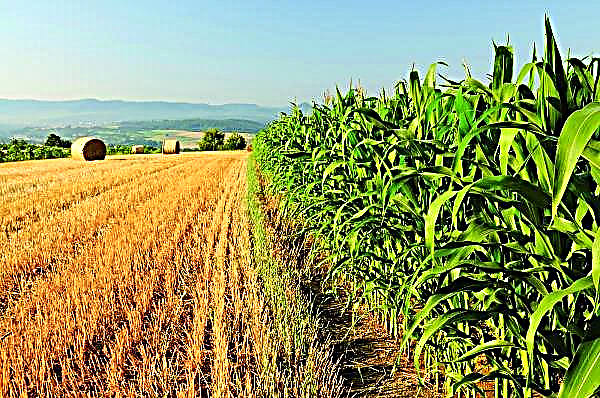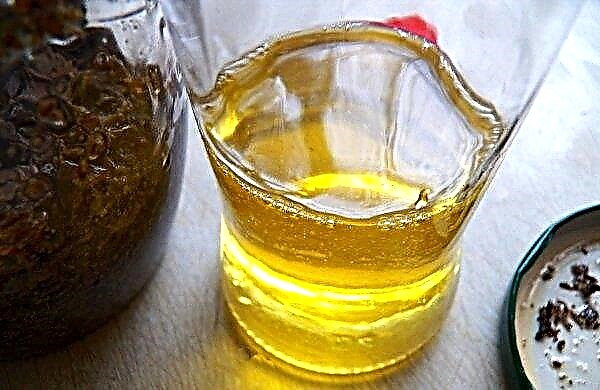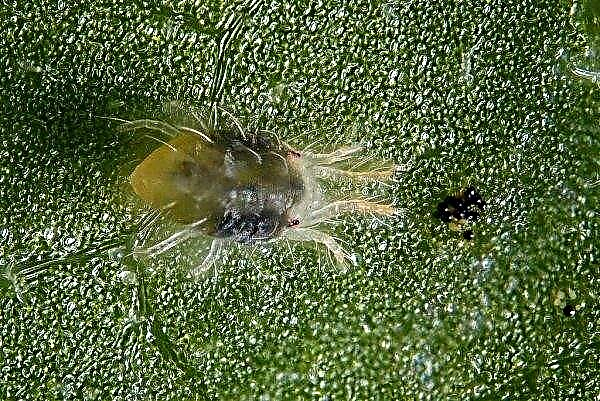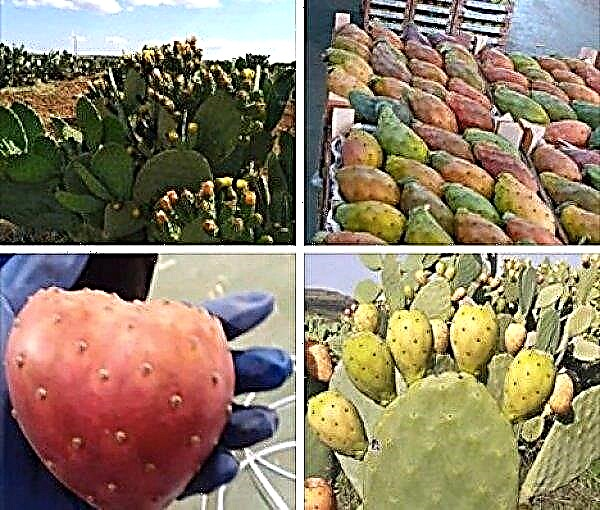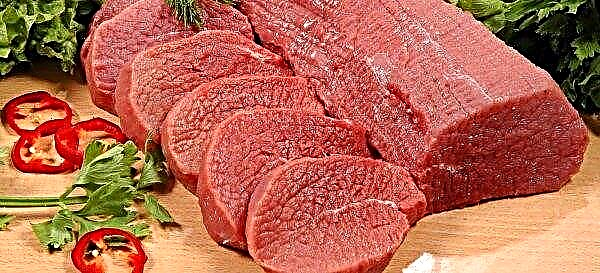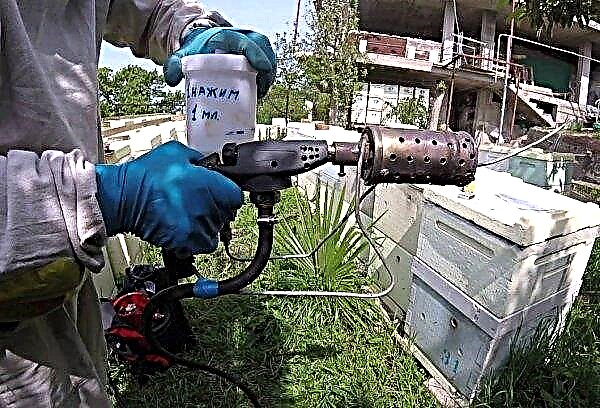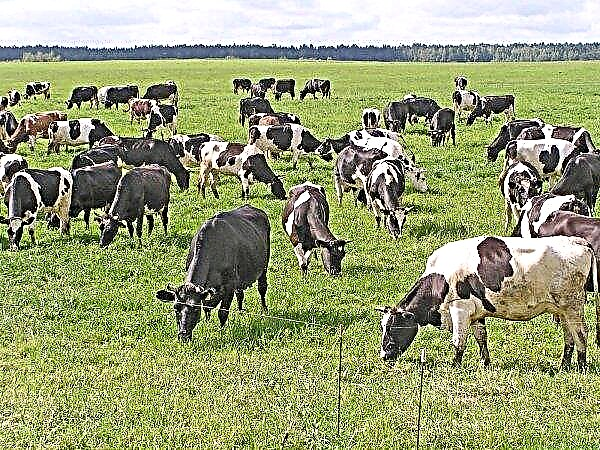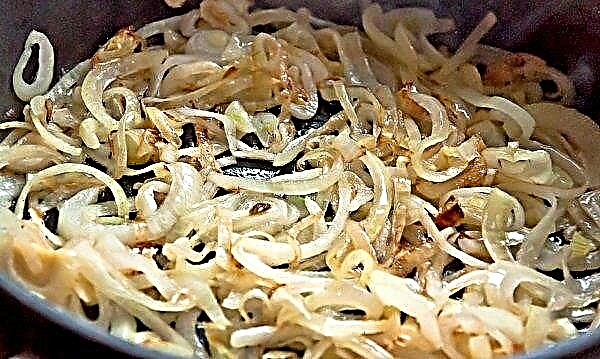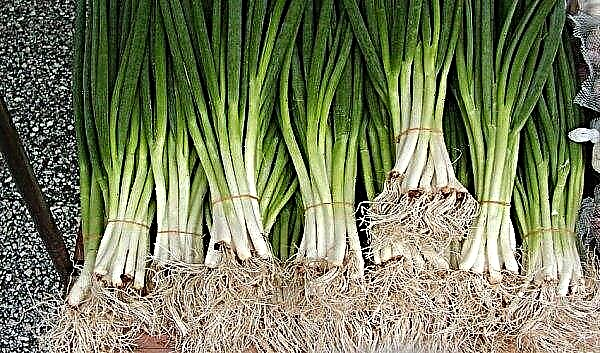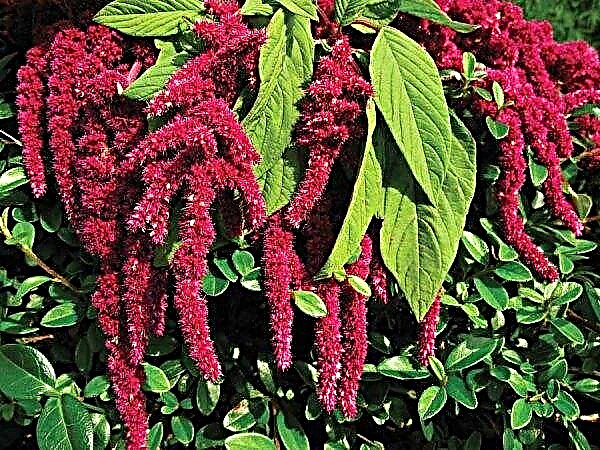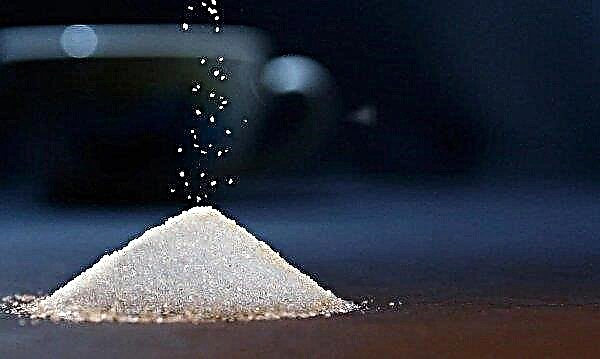The Zyatek F1 cucumber variety is unpretentious in maintenance, tolerates adverse climatic conditions and pleases the gardener with a generous harvest. A detailed description of this variety, especially planting, cultivation and care, possible pests and plant diseases - more on this later in the article.
Characterization and description of the variety
The variety was obtained by Russian breeders in Moscow in 2007. Zyatyok F1 cucumbers can be grown not only in open ground, but also in the greenhouse. An important feature of the variety is that a plentiful crop of vegetables can be obtained even in cool and rainy summers.
Characteristics of cucumbers Zyatek F1:Did you know? The surface of young cucumbers is covered with small spines. The fruits need them in order to better evaporate excess moisture from the pulp and peel.
- The bush is medium-sized, has many side weaving shoots.
- Leaves of medium size, green.
- The root system is branched, but fragile. The roots are located close to the surface of the earth.
- The variety is ripe, cucumbers ripen 45 days after the appearance of the first sprouts. The bush bears fruit until the end of September.
- Type of flowering - female. It does not need pollination by bees.
- Ovaries form in bundles; up to 50 bundles can form on one plant.
- The fruits are small, their length is 10-12 cm, diameter - 3.5 cm. The weight of one vegetable is about 100 g.
- The vegetables are covered with a thin dark green skin. Small pimples of white color are clearly visible on its surface.
- The pulp of cucumbers is juicy and crisp, contains small seeds.
- The fruits have a sweet taste and a pleasant aroma. When a vegetable overrides, its taste does not deteriorate.
- Productivity from 1 m² is 7-12 kg.

Advantages and disadvantages
Zyatek F1 belongs to the young varieties, but despite this, it has already gained popularity in many regions of Russia.
- These cucumbers are chosen for growing due to their many positive qualities:
- high productivity;
- good taste characteristics;
- early maturity and prolonged bearing;
- unpretentiousness in leaving;
- immunity to diseases;
- high seed germination rate;
- resistance to adverse climatic conditions;
- the possibility of growing in open ground or in a greenhouse;
- the possibility of using small cucumbers for canning for the winter;
- good transportability of vegetables.
- The disadvantages of the plant include:
- too fragile roots located close to the soil surface;
- the need for a separate container for each sprout when growing seedlings;
- sensitivity to cold watering;
- high price of seeds.
Optimal landing times
When growing cucumbers from seedlings, seeds can be sown in containers with soil at the end of April.
When planting the seeds of cucumbers of this variety in open soil, it is necessary to exclude the likelihood of night frosts, as they can destroy the seeds. Sowing planting material in the soil is necessary only after the night air temperature does not fall below + 12 ° C. Typically, cucumber seeds are sown in open ground at the end of May.Important! In pursuit of an early harvest, it is not recommended to start growing seedlings too early, as in this case the seedlings will turn out to be overgrown and will suffer a worse transplant.

Planting and growing cucumbers
Zyatyok F1 cucumbers are grown from seeds. For planting, you can use only purchased planting material, since the variety is a hybrid and seeds collected independently from last year's crop do not transmit their characteristics to plants grown from them. Cultivation can be carried out in seedlings and seedlings. Each has its own characteristics, so we will consider them separately.
Seedling method
The advantage of the method is the ability to obtain an early crop. But the fragile roots of seedlings require careful handling when transplanting seedlings in open ground.
Important! By the time the seedlings are transplanted into the open ground, they should have from 2 to 4 green leaves.
A detailed description of the process of sowing seeds for growing seedlings:
- Prepare separate glasses for each seed. It is impossible to plant seeds in one large capacity, since in this case, when transplanting seedlings into open ground, their roots can be accidentally damaged.
- Take the required amount of soil from the area on which plant sprouts will be planted in the future. Mix the soil with peat, humus, ash and sand.
- Arrange the mixture in individual glasses so that only one third of the container is filled. Lightly pour warm water on the ground.
- Make a 2-3 cm deepening in the soil and place 1 seed in it. Sprinkle with earth.
- Put the glasses with seeds in a bright place and keep at a temperature of + 25 ... + 30 ° С until emergence.
- Water the seeds every 1-2 days with settled water at room temperature.
- After a couple of green leaves appear on a young seedling, gradually add soil to the pot as the sprout grows.
- A week before the planned transplant of sprouts into the open ground, begin hardening of seedlings. To do this, containers with seedlings are briefly taken out onto the street or balcony. The time spent by seedlings in the open air at first should not exceed 20-30 minutes, then it is gradually increased.
- In late May or early July, plant seedlings in open ground. Seedlings must be carefully removed from individual containers together with an earthen lump and placed in holes in the plot. Then gently sprinkle the roots with earth.
Video: Growing cucumber seedlings
In a reckless way
In order for the Zyatyak F1 cucumber bushes to give a plentiful harvest of vegetables, you need to plant them in a correctly selected plot.
Tips for choosing a place to land:
- the site should have a sufficient area, because cucumbers require a lot of free space for growth. The number of plants per 1 m² should not exceed 4–5 pcs.;
- the soil on the site should be nutritious and light to allow air and water to pass through;
- so that the plants do not wilt in the hot sun, it is better to place a place for cucumbers in partial shade. You can select areas that are brightly lit by the sun only in the morning or in the evening.
 In order for the planted seeds of cucumbers to germinate, you need to prepare the soil in advance at the selected site for planting. Step-by-step algorithm for preparing beds:
In order for the planted seeds of cucumbers to germinate, you need to prepare the soil in advance at the selected site for planting. Step-by-step algorithm for preparing beds:- In the fall, apply fertilizer to the soil to saturate it with nutrients. As a top dressing, use peat, manure, wood ash, humus or ready-made fertilizer complexes.
- Dig the land in the area so that the fertilizer is mixed better with the soil.
- In the spring, once again cover the area with manure and water the soil with a hot solution of potassium permanganate for disinfection. Add top dressing containing potassium and phosphorus.
- A few days before planting, loosen the surface of the soil, eliminating large clods of earth. This is necessary in order to facilitate the germination of seeds.
- Before planting, moisten the soil in the area. In moist soil, seeds will germinate faster.
- When planting cucumber seeds in open ground, it is better to form a high ridge.
 Detailed description of the landing process:
Detailed description of the landing process:- Form a bed of 70 cm wide and 20 cm high from the soil.
- Place planting material in a small depression on the bed, sprinkle with earth. The distance between adjacent seeds should be at least 50 cm.
- Water the seeds periodically until small green shoots appear. This occurs within 10 days after planting.
Cucumber care after planting
After the cucumber seeds sprouted, and the growth process of the green part of the bush has begun, it is necessary to ensure proper care. The plant needs enough water and fertilizer so that flowering is plentiful and fruit ovaries form.
The soil around the bushes also needs proper care. Consider the features of caring for cucumbers Zyatek F1.Did you know? The pulp of cucumber is almost 95% water.
Top dressing and proper watering
This variety of cucumbers does not need specific care. But for the development of the plant you need to water it enough. If this procedure is carried out incorrectly, the bush may become ill and even die.
When watering cucumbers Zyatyok F1, you must adhere to such rules:
- water the plants only with warm water, as bushes can get sick from cold water and slow down their growth;
- it is impossible to suppose a saturation of soil with moisture, this can cause rot and powdery mildew on plants;
- the frequency of watering depends on weather conditions and is 2-3 times a week;
- after watering, the soil around the bush should be well moistened, but not sour;
- watering is carried out under the root in the early morning.
 On flowering cucumber bushes Zyatyok F1, after flowering, many ovaries and fruits are formed, and the bush itself is actively increasing lateral green shoots. In order for the plant to have enough strength for the growth and ripening of the fruit, it is necessary to make top dressing.
On flowering cucumber bushes Zyatyok F1, after flowering, many ovaries and fruits are formed, and the bush itself is actively increasing lateral green shoots. In order for the plant to have enough strength for the growth and ripening of the fruit, it is necessary to make top dressing.You can use store-bought complex fertilizers that contain all the nutrients necessary for cucumbers. You need to make them 3-4 times during the growing season of the plant at equal intervals.
As a top dressing also use:
- phosphorus and potassium fertilizers - for the active formation of fruits;
- manure - to stimulate the appearance of inflorescences;
- Mullein solution - saturates the soil with useful organic compounds.
Video: What and when to feed cucumbers
Bush garter and shaping
The shoots of cucumbers Zyatyok F1 in good growing conditions grow quickly and make the plant bush lush.
Usually in the area with plants they put low vertical columns or pegs, between which they stretch a kind of mesh made of metal wire or a strong cord. The long shoots of the bush are tied to this net, directing their growth in height.Important! In order for the lashes of cucumbers not to obscure each other, and the fruits to ripen in a timely manner, you need to establish supports for the bush.
Garter bush gives several advantages:
- Helps to eliminate the excessive tightness of the stems of cucumbers;
- prevents fruit decay from contact with the ground, since in this case the shoots with cucumbers growing on them will be above the soil;
- provides all cucumbers with a sufficient amount of light, as a result of which they ripen evenly;
- makes daily picking vegetables more convenient.
 Bushes of cucumbers Zyatёk F1 also need to be formed. During harvest, some stems may be damaged, and leaves may break. Damaged areas of shoots should be removed periodically in the early morning so that they do not take strength from healthy shoots. You also need to ensure that there are no shoots on the bush without inflorescences. If the length of the lash of the bush has reached 0.5 m, and there are no inflorescences on it, then it is better to trim it.
Bushes of cucumbers Zyatёk F1 also need to be formed. During harvest, some stems may be damaged, and leaves may break. Damaged areas of shoots should be removed periodically in the early morning so that they do not take strength from healthy shoots. You also need to ensure that there are no shoots on the bush without inflorescences. If the length of the lash of the bush has reached 0.5 m, and there are no inflorescences on it, then it is better to trim it.Soil care
Cucumbers grow well in loose and moderately moist soil, through which air passes well to the roots of the bush. When caring for the soil around plants adhere to such recommendations:
- weeds around the bush should be regularly removed so that they do not draw moisture and nutrients from the ground;
- periodically loosen the top layer of earth around the cucumbers, being careful not to damage the roots of the bush;
- mulch the surface of the soil near the plant with peat or humus to keep the soil moist and loose for longer.
Possible growing difficulties
Zyatek F1 cucumbers have a stable immunity to most diseases. But with improper care, they can be affected by diseases or pests, so you need to know how to treat plants from possible ailments, namely:
- Gray rot. Occurs when watering is too heavy or when using cold water. Signs of the disease are slippery, wet coating on the leaves of the plant. To treat gray rot, the leaves of the bush need to be treated with an aqueous solution of chalk and potassium permanganate. In addition, adjustments are made to the watering regime of the plant.
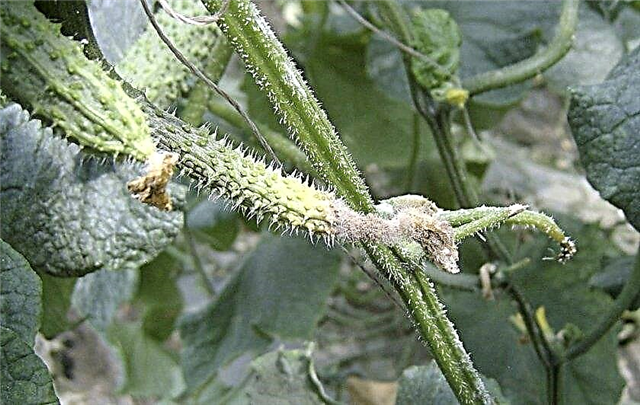
- Fungal diseases. May occur with waterlogged soil in combination with intense heat. Signs of infection can be yellow-brown spots on the leaves of the bush and watery areas on the surface of the cucumbers. All affected leaves and fruits need to be cut and burned. To prevent the recurrence of the disease, make adjustments to the watering regime and, if necessary, shade the plant from the bright sun.
- Peronosporosis. The disease can occur in conditions of high humidity and a sharp decrease in air temperature. At the same time, a characteristic gray coating appears on the surface of the leaves and fruits of the plant. To cope with the disease at the initial stage, cucumbers are irrigated with whey. If such treatment does not give a result, then chemical preparations are used.
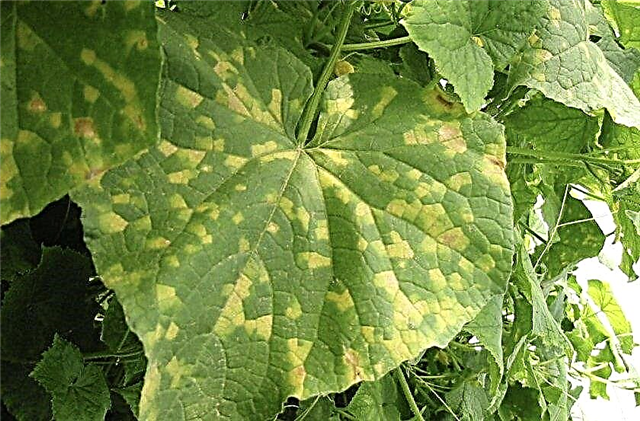
Most often, Zyatek F1 cucumbers are grown in open ground, so they are not immune to pests. Bushes can be attacked by such insects:Did you know? The homeland of cucumbers is the mountain foot of the Himalayas. There still grow wild species of cucumbers.
- Maybug larva. It can eat the leaves and roots of cucumbers, as well as the fruits themselves. In order to kill the pest, special chemicals from pests are used. It is better to carry out preventive treatment of plants before planting. To do this, add a drug against this pest to each well (for example, Rembek).

- Aphid. Settles on the leaves of the bush and drinks all the juices from them. The presence of this pest is evidenced by a large number of ants running along the surface of the bush. If there are few insects, you can cut off the affected leaves of cucumbers and burn them. You can treat the leaves of the bush with an aqueous solution of soda. But with a large number of pests, it is recommended to use special preparations against pests (for example, Fitoverm).

- Spider mite. It can affect the leaves of cucumbers in late summer, causing them to wilt. A sign of the presence of insects on the plant are thin holes on the leaves of cucumbers and a thin white web. The affected leaves of the bush must be cut and burned, and the plant treated with a solution of insecticides.
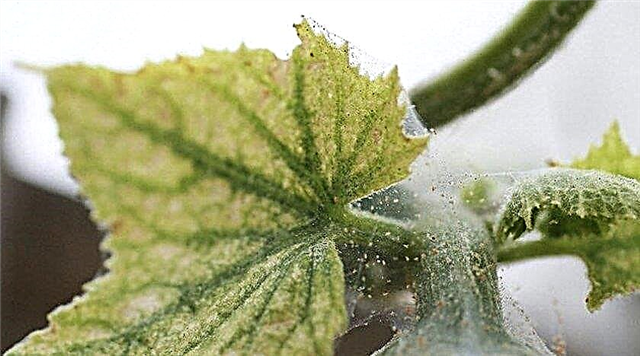
Harvesting
The first portion of ripe fruits is harvested 1.5 months after the appearance of the first seedlings. You can collect fruits measuring 5-7 cm or wait until they grow larger. In general, the plant bears fruit until the end of September.
The rules for the collection and storage of the harvest of cucumbers Zyatyok F1:
- you need to collect ripe vegetables from the bush every day;
- it is better to collect ripe vegetables in the morning;
- you need to store the crop in a dark and cool place - a cellar or a refrigerator;
- fresh cucumbers can be stored for 5–7 days;
- with prolonged storage, vegetables deteriorate, and their taste deteriorates.
The many advantages of the Zyatok F1 variety make it popular for growing among gardeners. In order for the plant to produce many tasty and beautiful fruits, it is enough to adhere to the recommendations for cultivation described above and provide cucumbers with simple care.Important! Overgrown cucumbers have a not very beautiful barrel-shaped and stiff peel.






